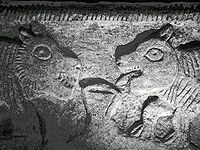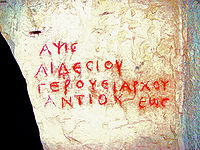
Beit She'arim National Park
Encyclopedia



Necropolis
A necropolis is a large cemetery or burial ground, usually including structural tombs. The word comes from the Greek νεκρόπολις - nekropolis, literally meaning "city of the dead"...
is part of the Beit She'arim National Park, which borders the town of Kiryat Tiv'on on the northeast and is located close to the modern moshav of Beit She'arim
Beit She'arim
Beit She'arim is a moshav in northern Israel. Located in the Galilee near Ramat Yishai, it falls under the jurisdiction of Jezreel Valley Regional Council. In 2006 it had a population of 528....
. It is situated 20 km east of Haifa
Haifa
Haifa is the largest city in northern Israel, and the third-largest city in the country, with a population of over 268,000. Another 300,000 people live in towns directly adjacent to the city including the cities of the Krayot, as well as, Tirat Carmel, Daliyat al-Karmel and Nesher...
in the southern foothills of the Lower Galilee. The park is managed by the Israel Nature and Parks Authority.
According to Moshe Sharon, following Kutcher, the name of the city was more correctly Beit She'arayim (the House (or Village) of Two Gates).
History
Beit She'arim was founded at the end of the 1st century BCE, during the reign of King HerodHerod the Great
Herod , also known as Herod the Great , was a Roman client king of Judea. His epithet of "the Great" is widely disputed as he is described as "a madman who murdered his own family and a great many rabbis." He is also known for his colossal building projects in Jerusalem and elsewhere, including his...
. It was a prosperous Jewish town until destroyed by fire in 352, at the end of the Jewish revolt against Gallus. After some time it was renewed as a Byzantine
Byzantine
Byzantine usually refers to the Roman Empire during the Middle Ages.Byzantine may also refer to:* A citizen of the Byzantine Empire, or native Greek during the Middle Ages...
city. From the early Arab period (7th century), settlement was sparse. A small Arab village called Sheikh Bureik
Sheikh Bureik, Lajjun
Sheikh Bureik, also called Sheikh Abreik or Sheikh Ibreik, was a Palestinian Arab village located southeast of Haifa. Situated at an ancient site that shows evidence of habitation as early as the Iron Age, it was an important center of Jewish learning in the 2nd century, with habitation continuing...
was located here in the late 16th century.
The Roman Jewish historian Josephus Flavius referred to the city as Besara, the administrative center of the estates of Queen Berenice in the Jezreel Valley. After the destruction of the Second Temple
Second Temple
The Jewish Second Temple was an important shrine which stood on the Temple Mount in Jerusalem between 516 BCE and 70 CE. It replaced the First Temple which was destroyed in 586 BCE, when the Jewish nation was exiled to Babylon...
in 70 CE, the Sanhedrin (Jewish legislature and supreme council) moved to Beit She'arim. Rabbi Judah HaNasi
Judah haNasi
Judah the Prince, or Judah I, also known as Rebbi or Rabbeinu HaKadosh , was a 2nd-century CE rabbi and chief redactor and editor of the Mishnah. He was a key leader of the Jewish community during the Roman occupation of Judea . He was of the Davidic line, the royal line of King David, hence the...
, head of the Sanhedrin
Sanhedrin
The Sanhedrin was an assembly of twenty-three judges appointed in every city in the Biblical Land of Israel.The Great Sanhedrin was the supreme court of ancient Israel made of 71 members...
and compiler of the Mishna, lived there. In the last seventeen years of his life, he moved to Sepphoris for health reasons, but planned his burial in Beit She'arim on land he received as a gift from his friend, the Roman emperor Marcus Aurelius Antoninus. The most desired burial place for Jews was the Mount of Olives
Mount of Olives
The Mount of Olives is a mountain ridge in East Jerusalem with three peaks running from north to south. The highest, at-Tur, rises to 818 meters . It is named for the olive groves that once covered its slopes...
in Jerusalem, but in 135 CE, when Jews were barred from the area, Beit She'arim became an alternative.
The archaeological importance of the site was recognized in the 1880s by the Survey of Western Palestine, which explored many tombs and catacombs but did no excavation. The Arab Palestinian
Palestinian people
The Palestinian people, also referred to as Palestinians or Palestinian Arabs , are an Arabic-speaking people with origins in Palestine. Despite various wars and exoduses, roughly one third of the world's Palestinian population continues to reside in the area encompassing the West Bank, the Gaza...
village of Sheikh Bureik was located on the hill until the 1920s, when the land was purchased by the Jewish National Fund
Jewish National Fund
The Jewish National Fund was founded in 1901 to buy and develop land in Ottoman Palestine for Jewish settlement. The JNF is a quasi-governmental, non-profit organisation...
. In 1936, Alexander Zaïd
Alexander Zaïd
Alexander Zaïd was one of the founders of the Jewish defense organizations Bar Giora and Hashomer, and a prominent figure of the Second Aliyah.-Biography:Zaïd was born in 1886 in Zima, a town in Irkutsk Oblast, Siberia...
, employed by the JNF as a watchman, reported that he had found a breach in the wall of one of the caves which led into another cave decorated with inscriptions. In the 1930s and 1950s, the site was excavated by Benjamin Mazar
Benjamin Mazar
Benjamin Mazar was a pioneering Israeli historian, recognized as the "dean" of biblical archaeologists. He shared the national passion for the archaeology of Israel that also attracts considerable international interest due to the region's biblical links...
and Nahman Avigad
Nahman Avigad
Dr. Nahman Avigad , born in Zawalow, Galicia , was an Israeli archaeologist.-Biography:...
.
Jewish necropolis
Most of the remains date from the 2nd to 4th century CE. A large number of individuals was buried in the more than twenty catacombs of the necropolis. Geographical references in inscriptions on the walls of the catacombs reveal that the necropolis was used by people from the town of Beit She'arim, from elsewhere in Galilee, and even from cities as far away as PalmyraPalmyra
Palmyra was an ancient city in Syria. In the age of antiquity, it was an important city of central Syria, located in an oasis 215 km northeast of Damascus and 180 km southwest of the Euphrates at Deir ez-Zor. It had long been a vital caravan city for travellers crossing the Syrian desert...
and Tyre.
The Jerusalem Talmud
Jerusalem Talmud
The Jerusalem Talmud, talmud meaning "instruction", "learning", , is a collection of Rabbinic notes on the 2nd-century Mishnah which was compiled in the Land of Israel during the 4th-5th century. The voluminous text is also known as the Palestinian Talmud or Talmud de-Eretz Yisrael...
cites Beit She'arim as the burial place of Rabbi Judah HaNasi. His funeral is described as follows: "Miracles were wrought on that day. It was evening and all the towns gathered to mourn him, and eighteen synagogues praised him and bore him to Bet Shearim, and the daylight remained until everyone reached his home (Ketubot 12, 35a)." The fact that Rabbi Judah was buried here is believed to be a major reason for the popularity of the necropolis in Late Antiquity. One of the catacombs, (nr. 14 with a clear inscription saying his name and title) has been identified as his burial site.
Glassmaking industry
In 1956, a bulldozer working at the site unearthed an enormous rectangular slab, 11×6.5×1.5 feet, weighing 9 tons. Initially, it was paved over, but it was eventually studied and found to be a gigantic piece of glass. An ancient glassmaking furnace was located here, which produced great batches of molten glass that were cooled and later broken into small pieces for crafting glass vessels.Recent discoveries
In October 2009, two new caves were opened to the public whose burial vaults date to the first two centuries CE.External links
- Pictures of Beit She'arim Israel in Photos
- Beth She'arim, Suggestion to have Beth She'arim recognized as a UNESCO world heritage site, in 2002

